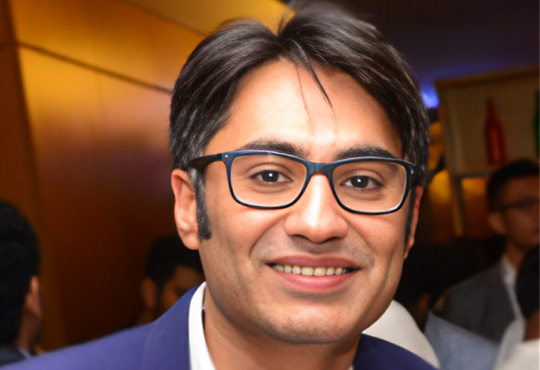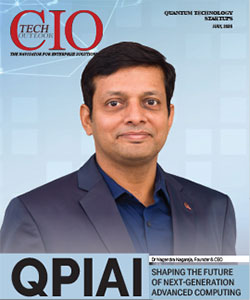Transforming Realities: The Impact and Future of Projection Mapping Technology
Rishubh Nayar, Director, Christie Digital Systems India Pvt Ltd
 Rishubh brings over 12 years of expertise in account management, market development, business analysis, and sales. He excels in promoting Christie’s advanced visual solutions to clients and partners across India and SAARC nations, driving business growth through strategic channels.
Rishubh brings over 12 years of expertise in account management, market development, business analysis, and sales. He excels in promoting Christie’s advanced visual solutions to clients and partners across India and SAARC nations, driving business growth through strategic channels.In a conversation with CIOTechOutlook magazine, Rishubh Nayar shared his views and thoughts on how projection mapping technology is revolutionizing educational experiences as well as how businesses are leveraging this technology to enhance customer engagement and brand storytelling.
How is projection mapping technology reshaping people's experience of live events, entertainment, and public spaces?
With projection mapping, almost any surface can be layered with dynamic visuals. Through precise calibration and synchronisation, images and video can be warped and blended to fit perfectly on irregularly shaped surfaces. So this enables buildings, interior spaces, objects, and even natural landscapes to act as a canvas that elevates audience immersion.
For instance, Australia's famous Gold Coast Convention and Exhibition Centre recently leveraged pure laser projectors, despite operating in an environment favouring LED screens. These high-brightness projectors came with powerful processing systems as well as intuitive auto-alignment and show control tools. That effectively overcame rigging and power constraints to provide a vivid, bright, and colourful light output in a room with high ambient light.
How projection mapping technology is revolutionizing educational experiences, both in traditional classroom settings and online learning environments?
For instance, Australia's famous Gold Coast Convention and Exhibition Centre recently leveraged pure laser projectors, despite operating in an environment favouring LED screens. These high-brightness projectors came with powerful processing systems as well as intuitive auto-alignment and show control tools. That effectively overcame rigging and power constraints to provide a vivid, bright, and colourful light output in a room with high ambient light.
How projection mapping technology is revolutionizing educational experiences, both in traditional classroom settings and online learning environments?
Well, pedagogy is of course always looking for innovative ways to get teaching and learning to resonate with students. Projection mapping is but one way to do this, as it creates more immersive and interactive experiences.
For example, educators can tap into the visual aspects of learning as students can be in the thick of their lessons. This is highly significant with today’s generation of learners, who for better or worse, are more accustomed to learning through screens. High-quality display technology brings life-like visuals into the classroom or lecture hall, which can significantly raise student engagement. For example, last year, an innovative 360-degree immersive VR laboratory at a public research university in Shanghai, China, benefited students by exposing them to advanced projection and 3D interactive technologies.
At the same time, high-quality display tools can also be more intuitive, which simplifies user experience and boosts learning outcomes. These can range from easy-to-use wireless remote controls to map out 3D visualisations, all of which elevate content across curricula.
How are businesses leveraging this technology to enhance customer engagement and brand storytelling?
For example, educators can tap into the visual aspects of learning as students can be in the thick of their lessons. This is highly significant with today’s generation of learners, who for better or worse, are more accustomed to learning through screens. High-quality display technology brings life-like visuals into the classroom or lecture hall, which can significantly raise student engagement. For example, last year, an innovative 360-degree immersive VR laboratory at a public research university in Shanghai, China, benefited students by exposing them to advanced projection and 3D interactive technologies.
At the same time, high-quality display tools can also be more intuitive, which simplifies user experience and boosts learning outcomes. These can range from easy-to-use wireless remote controls to map out 3D visualisations, all of which elevate content across curricula.
How are businesses leveraging this technology to enhance customer engagement and brand storytelling?
I think if you look at what it means to engage people; it typically boils down to moving narratives. You want to tap into the intellectual and the sensory aspect of people’s experiences with these stories. Light and sound augment stories with colours, music, sound conflict, dialogue, and emotions. This allows the audience to relate the plot to their feelings in the moment. Given that visual storytelling is one of the most potent forms to connect with people, projection mapping enables brands to build on a good narrative and keep their target demographic compelled.
What policies or initiatives are necessary to promote the adoption of projection mapping in tourism?
Well, light and sound shows are a major part of experiencing India’s rich cultural heritage. For instance, there is the nightly 40-minute light and sound show of Lord Krishna’s life on the façade of the Sri Krishna Janmabhoomi Temple in Uttar Pradesh. There’s also the creation of a son et lumière at Gwalior Fort in Madhya Pradesh, and Leh Palace, a former royal palace overlooking the city of Leh in Ladakh. These are just some notable examples, but the wider point is that India’s cultural fabric lends itself intuitively to projection mapping.
That being said, promoting greater adoption will hinge on exploring ways to leverage projection mapping to foster cultural and community engagement more widely. For instance, landmarks in more densely populated areas can also be used as backdrops to tell stories about the people that live there, to create awareness around current issues, as well as reach wider audiences when it comes to official information.
As virtual and augmented reality technologies continue to evolve, how do you see projection mapping intersecting with these technologies to create even more immersive and interactive?
Well, as with anything new, there are enthusiasts and cynics. On the one hand, there is immense potential to truly elevate the entertainment quotient through VR/AR. However, there are of course issues around convenience, as the headsets that these technologies run on are considered intrusive in some quarters. I think it’s important to be measured about the intersection of these technologies and projection mapping.
The transition from novelty to mainstream is neither easy nor guaranteed, but it’s a leap these technologies will need to make eventually. A key hurdle to universal acceptance will likely come from how seamlessly it integrates as the lines between real and virtual blur. These technologies may feel impractical now, but it is certainly possible that they can evolve so as to not come at the cost of convenience.
How do you envision projection mapping technology contributing to sustainability initiatives in the future?
One simple way projection mapping can lead to better environmental outcomes is that it reduces wastage by minimising the need for physical construction of elaborate sets.
But there also needs to be product design that takes a climate-conscious approach. Indeed, power consumption by projectors are significant emitters while also being the biggest driver of total cost of ownership.
For example, the Christie Griffyn 4K50-RGB pure laser projector has a brightness output of 50,000 lumens, but does so by generating an incredible 15.9 lumens per watt. This makes it the most energy-efficient laser projector available today in its class, with comparable projectors deliver on average 10 lumens per watt. That means 50% more light for each watt-hour consumed, 33% less power consumed, a 33% smaller carbon footprint, and 33% savings on electricity.
What policies or initiatives are necessary to promote the adoption of projection mapping in tourism?
Well, light and sound shows are a major part of experiencing India’s rich cultural heritage. For instance, there is the nightly 40-minute light and sound show of Lord Krishna’s life on the façade of the Sri Krishna Janmabhoomi Temple in Uttar Pradesh. There’s also the creation of a son et lumière at Gwalior Fort in Madhya Pradesh, and Leh Palace, a former royal palace overlooking the city of Leh in Ladakh. These are just some notable examples, but the wider point is that India’s cultural fabric lends itself intuitively to projection mapping.
That being said, promoting greater adoption will hinge on exploring ways to leverage projection mapping to foster cultural and community engagement more widely. For instance, landmarks in more densely populated areas can also be used as backdrops to tell stories about the people that live there, to create awareness around current issues, as well as reach wider audiences when it comes to official information.
As virtual and augmented reality technologies continue to evolve, how do you see projection mapping intersecting with these technologies to create even more immersive and interactive?
Well, as with anything new, there are enthusiasts and cynics. On the one hand, there is immense potential to truly elevate the entertainment quotient through VR/AR. However, there are of course issues around convenience, as the headsets that these technologies run on are considered intrusive in some quarters. I think it’s important to be measured about the intersection of these technologies and projection mapping.
The transition from novelty to mainstream is neither easy nor guaranteed, but it’s a leap these technologies will need to make eventually. A key hurdle to universal acceptance will likely come from how seamlessly it integrates as the lines between real and virtual blur. These technologies may feel impractical now, but it is certainly possible that they can evolve so as to not come at the cost of convenience.
How do you envision projection mapping technology contributing to sustainability initiatives in the future?
One simple way projection mapping can lead to better environmental outcomes is that it reduces wastage by minimising the need for physical construction of elaborate sets.
But there also needs to be product design that takes a climate-conscious approach. Indeed, power consumption by projectors are significant emitters while also being the biggest driver of total cost of ownership.
For example, the Christie Griffyn 4K50-RGB pure laser projector has a brightness output of 50,000 lumens, but does so by generating an incredible 15.9 lumens per watt. This makes it the most energy-efficient laser projector available today in its class, with comparable projectors deliver on average 10 lumens per watt. That means 50% more light for each watt-hour consumed, 33% less power consumed, a 33% smaller carbon footprint, and 33% savings on electricity.




